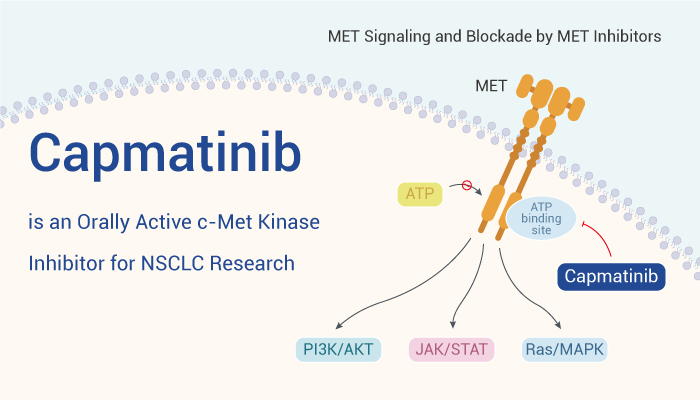C-MET is a hepatocyte growth factor (HGF) receptor with tyrosine kinase activity. The binding of HGF to c-MET results in receptor multimerization, phosphorylation and catalytic activation. And subsequently recruits GRB1/2, SHC, and c-Cbl, leading to the activation of multiple downstream effector pathways or proteins. Including RAS/MAPK (mitogen-activated protein kinase), PI3K (phosphoinositide-3 kinase)/AKT, FAK (focal adhesion kinase), STAT3/5, RAC/RHO, PLC-y (phospholipase Cy), c-SRC, SHP2 (Src homology 2-containing tyrosine phosphatase). These processes regulate cell growth, survival, motility, and invasion. However, aberrant c-MET activation, frequently occurs in many human solid tumors and hematologic malignancies, especially in non-small-cell lung cancer (NSCLC).
Here is an orally available, selective, ATP-competitive c-Met kinase inhibitor, Capmatinib.
Capmatinib (INC280; INCB28060) is a reversible c-Met kinase inhibitor (IC50=0.13 nM). It (0.06-62.25 nM; 2h) inhibits the phosphorylation of c-MET, EGFR and HER-3 as well as c-MET pathway downstream effector proteins such as ERK1/2, AKT, FAK, GAB1 and STAT3/5. It effectively inhibits the proliferation and migration of c-Met-dependent tumor cells and effectively induces apoptosis in SNU-5 cells.
Capmatinib exhibits antitumor activity in the U-87MG tumor mouse model. Capmatinib is primarily metabolized by CYP3A4 and aldehyde oxidase. (1-30 mg/kg; po; twice daily for 2 weeks) exerted a dose-dependent inhibition of tumor growth and was well tolerated with no significant toxicity or weight loss. (0.03-10 mg/kg; PO, single dose) also inhibits c-MET phosphorylation in a mouse model of S114 tumors.
In summary, Capmatinib is an orally active, reversible, ATP-competitive c-Met kinase inhibitor that can inhibit cancer cell proliferation and migration and induce cancer cell apoptosis. It can be used for NSCLC research.
Reference:
[1] Liu X, et al. Clin Cancer Res. 2011 Nov 15;17(22):7127-38.
